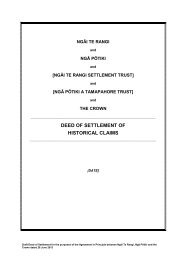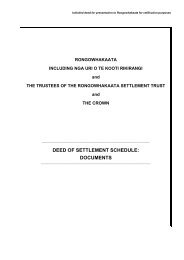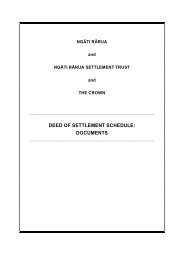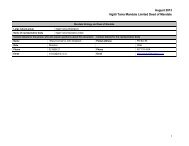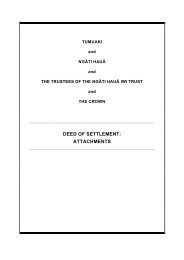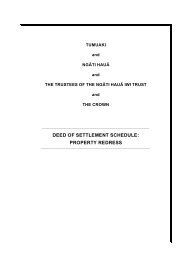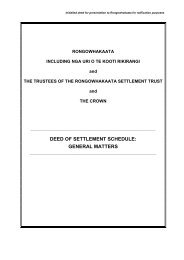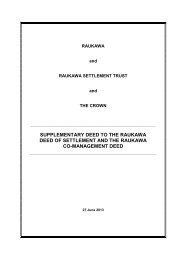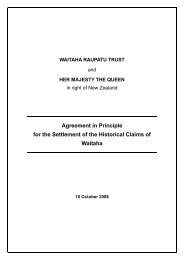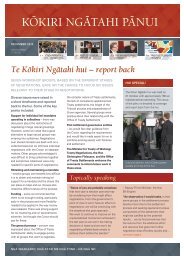Ngati Haua Deed of Settlement - Terabyte Interactive
Ngati Haua Deed of Settlement - Terabyte Interactive
Ngati Haua Deed of Settlement - Terabyte Interactive
You also want an ePaper? Increase the reach of your titles
YUMPU automatically turns print PDFs into web optimized ePapers that Google loves.
NGĀTI HAUĀ DEED OF SETTLEMENT2 HISTORICAL ACCOUNTINTRODUCTION2.1 This historical account describes the relationship between the Crown and Ngāti Hauāfrom 1840 and identifies Crown actions and omissions which have caused grievance toNgāti Hauā over the generations. It provides context for the Crown’s acknowledgement<strong>of</strong> its Treaty breaches against Ngāti Hauā and for the Crown’s apology to Ngāti Hauā.NGĀTI HAUĀ2.2 Ngāti Hauā descend from the eponymous ancestor Hauā, a direct descendant <strong>of</strong>Hoturoa, the captain <strong>of</strong> the Tainui waka. The hapū <strong>of</strong> Ngāti Hauā are Ngāti Te Oro,Ngāti Werewere, Ngāti Waenganui, Ngāti Te Rangitaupi and Ngāti Rangi Tawhaki.2.3 The customary rohe <strong>of</strong> Ngāti Hauā stretches from Te Aroha, south along the KaimaiRange to Te Weraiti, from Te Weraiti west to Maungatautari, from Maungatautarinorthwest to Te Rapa, from Te Rapa eastward to Mangateparu and from thence toTe Aroha. Ngāti Hauā also established interests outside this area, such as atŌmokoroa on the Tauranga Moana coastline. Ngāti Hauā also claimed non-exclusiveinterests to the west <strong>of</strong> Maungatautari.2.4 The Ngāti Hauā rohe included a rich and varied range <strong>of</strong> habitats and resources. Largeswamps were a valuable source <strong>of</strong> eels and water fowl. Extensive tracts <strong>of</strong> bush andforest land along the Kaimai Range and on Maungatautari and Maungakawa providedaccess to birds, rats and other sources <strong>of</strong> food and medicine. Other areas were usedfor cultivation. Ngāti Hauā consider a number <strong>of</strong> hot springs in their rohe to have been<strong>of</strong> customary significance for bathing, cooking and medicinal purposes.FIRST CONTACTS2.5 European technology began to have an impact on Ngāti Hauā from the early 1820sthrough the introduction <strong>of</strong> musket warfare into the region. Ngāti Hauā gave shelter torefugees from other iwi, but in 1830 tensions with those iwi gave rise to the battle <strong>of</strong>Taumatawiiwii on the northern slopes <strong>of</strong> Maungatautari. Ngāti Hauā maintain thatunder the formidable leadership <strong>of</strong> their paramount chief, Te Waharoa, Ngāti Hauāconsolidated their interests between Maungatautari north to Te Aroha. Ngāti Hauārefer to their lands as being held under the mana <strong>of</strong> Te Waharoa.2.6 The first European to enter Ngāti Hauā territory was likely a Kawhia trader who passedthrough the Matamata district in 1831 en route to Tauranga. Pigs and potatoes wereintroduced into the district before then through customary Māori trading networks.European trading posts that purchased flax from Ngāti Hauā in return for various goodswere established at Matamata, and later at Tahuna, close to the future site <strong>of</strong>Morrinsville.2.7 Protestant missionaries visited the area for the first time in 1833. Ngāti Hauāexpressed a strong desire to have their own missionaries. In 1835 a mission stationwas established close to Matamata pā located just outside present-day Waharoa. Apayment in goods was made for the land. Te Waharoa declared that the items handedover 'will soon be broken, worn out, and gone but the ground will endure forever tosupply our children and theirs.'10



